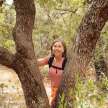The Amazing World of Fungi
Exploring woods we've owned for sixteen years, I found a whole new world waiting in the August shade.

Last year when we found an unusual-looking mushroom at our cabin, I was intrigued. As an environmental educator, I'm always on the lookout for new things to learn about. It seemed it was time I learn about fungi!
One day, as we hunted in our woods this August, we found several species of fungi growing. We found them sprouting up in different places, on the ground, on trees, and on dead wood. There were white ones, orange ones, green ones, and brown ones. Since I did not know how to identify the mushrooms we got out some reference books I had purchased when I worked for a local land trust and had to organize a foraging expedition.

All I knew was that unless one can positively identify a mushroom, one should not eat it! Fungi can be hallucinogenic, poisonous, or just tasty. I had no idea what species we were finding so we didn't eat any.
Surprisingly, the most unusual mushroom we found, was also the safest to eat. It was a Bear's Head Tooth Fungi growing on the face of a cut log. The color - a stark white - caught my eye in the verdant woods. As I got closer, I saw that there were icicle-like projections hanging down forming a growth on the log, perhaps 2 x 3 inches in size.

My eldest son was my fungi foraging partner and he was intrigued as well! After finding that, as well as a crop of orange gilled mushrooms growing on a dead tree stump both singly and in clusters, we headed inside to look at the reference books.
Bear's Head Tooth Fungi
The first fungi we looked up was the white one with the icicle-like projections. We were able to positively say it was Bear's Head Tooth. This fungus does not have gills or pores, but teeth (the hanging projections) instead. Its scientific name is Hericium americanum.
The reason we ate this fungi after cooking it was that Bear's Head Tooth has no look-alike species in North America. All Hericium is edible (Source). We felt we positively identified the fungi so we felt safe cooking it up. Supposedly, Bear's Head Tooth tastes like crabmeat. We did not get this flavor but we had very little of it to cook. I also believe we over cooked it. We did not have any untoward effects from eating the Bear's Head Tooth, not that we expected any.
Fungi Foraging
Foraging for fungi has been a great learning experience this year. I've learned some valuable tips. Some of these tips are on how one goes about properly identifying a mushroom.
Identification tips:
1) Take a photo of the cap, gills, and stipe (stem).
2) Note where the gills attach, begin, and end.
3) Not all fungi have gills. Some fungi have pores and some have teeth (like the Bear's Head or Lion's Mane). The underside of the cap is important in idenitification.
4) If taking photos for others to help you identify your mushrooms, make sure you include all these areas of the fruiting body (the part of the mushroom above the ground).
5) Note where the fungi is growing. Is it on dead wood? Is it on the ground? Is it on a living tree? Does it grow in clusters or singly?
All of the above are important aspects of identifying the type of fungus you are curious about.
Spore prints are extremely important in identifying fungi. Fungi reproduce with spores. They are not plants but belong to a separate Kingdom of living organisms. Spores have particular shapes and colors that help with the identification of fungi. We did not make any spore prints this summer. However, I have made spore prints in the past. It is a fun activity.
The one caveat to fungi foraging is that one does not eat anything that has not been positively identified by an expert on fungi. It is not something to take a chance on. If you don't know what you have found, DO NOT EAT it! Some fungi are poisonous, even deadly.

I hope to continue learning about fungi found in our Wisconsin woods, even if I don't eat them, they are interesting and make for great photos.


About the Creator
Carol Labuzzetta
Carol is an environmental educator who enjoys writing and photography. Using the science of awe, she has taught our youth to love the Earth for the last 20 years. Carol is inspired by nature, travel, and color. She is a published poet.






Comments
There are no comments for this story
Be the first to respond and start the conversation.